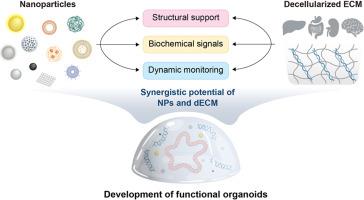纳米颗粒和脱细胞ECM在类器官工程中的应用进展
IF 10.2
1区 医学
Q1 ENGINEERING, BIOMEDICAL
引用次数: 0
摘要
类器官已经成为一种变革性的体外平台,与传统的二维(2D)培养相比,它提供了可靠的人体组织结构和功能的再现。同时,工程纳米颗粒(NPs)已被整合到类器官系统中,以增强支架功能,并扩大其在药物输送、毒性筛选和疾病建模方面的应用。此外,脱细胞胞外基质(dECM)在类器官培养中的应用引起了广泛关注,因为它提供了更接近原生生态位的组织特异性生化和机械线索,从而促进了类器官的成熟。本文综述了近年来关于NPs和dECM如何促进类器官生长和成熟的研究。它进一步讨论了它们在治疗开发和疾病建模方面的应用,以及针对精细类器官平台的新兴策略。最后,我们概述了NPs和dECM的联合利用如何通过提高结构和功能复杂性来进一步改善类器官的研究。总之,这些方法支持开发多功能类器官模型,在疾病建模、治疗筛选和再生医学中具有广泛的适用性。本文章由计算机程序翻译,如有差异,请以英文原文为准。

Recent advances in applications of nanoparticles and decellularized ECM for organoid engineering
Organoids have emerged as a transformative in vitro platform, offering reliable recapitulation of human tissue architecture and function compared to conventional two-dimensional (2D) cultures. Concurrently, engineered nanoparticles (NPs) have been integrated into organoid systems to enhance scaffold functionality and expand their application in drug delivery, toxicity screening, and disease modeling. Furthermore, decellularized extracellular matrix (dECM) has attracted wide attention for its application in organoid culture, as it provides tissue-specific biochemical and mechanical cues that more closely resemble the native niche, thereby promoting organoid maturation. This review summarizes recent studies that explore how NPs and dECM contribute to the growth and maturation of organoids. It further discusses their applications in therapeutic development and disease modeling, as well as emerging strategies toward refined organoid platforms. Lastly, we outlined how the combined utilization of NPs and dECM may further improve organoid research by enhancing both structural and functional complexity. Together, these approaches support the advancement for developing multifunctional organoid models with broad applicability in disease modeling, therapeutic screening, and regenerative medicine.
求助全文
通过发布文献求助,成功后即可免费获取论文全文。
去求助
来源期刊

Materials Today Bio
Multiple-
CiteScore
8.30
自引率
4.90%
发文量
303
审稿时长
30 days
期刊介绍:
Materials Today Bio is a multidisciplinary journal that specializes in the intersection between biology and materials science, chemistry, physics, engineering, and medicine. It covers various aspects such as the design and assembly of new structures, their interaction with biological systems, functionalization, bioimaging, therapies, and diagnostics in healthcare. The journal aims to showcase the most significant advancements and discoveries in this field. As part of the Materials Today family, Materials Today Bio provides rigorous peer review, quick decision-making, and high visibility for authors. It is indexed in Scopus, PubMed Central, Emerging Sources, Citation Index (ESCI), and Directory of Open Access Journals (DOAJ).
 求助内容:
求助内容: 应助结果提醒方式:
应助结果提醒方式:


